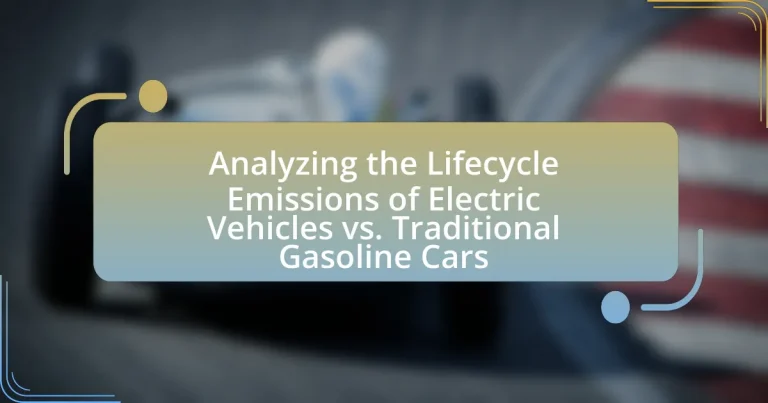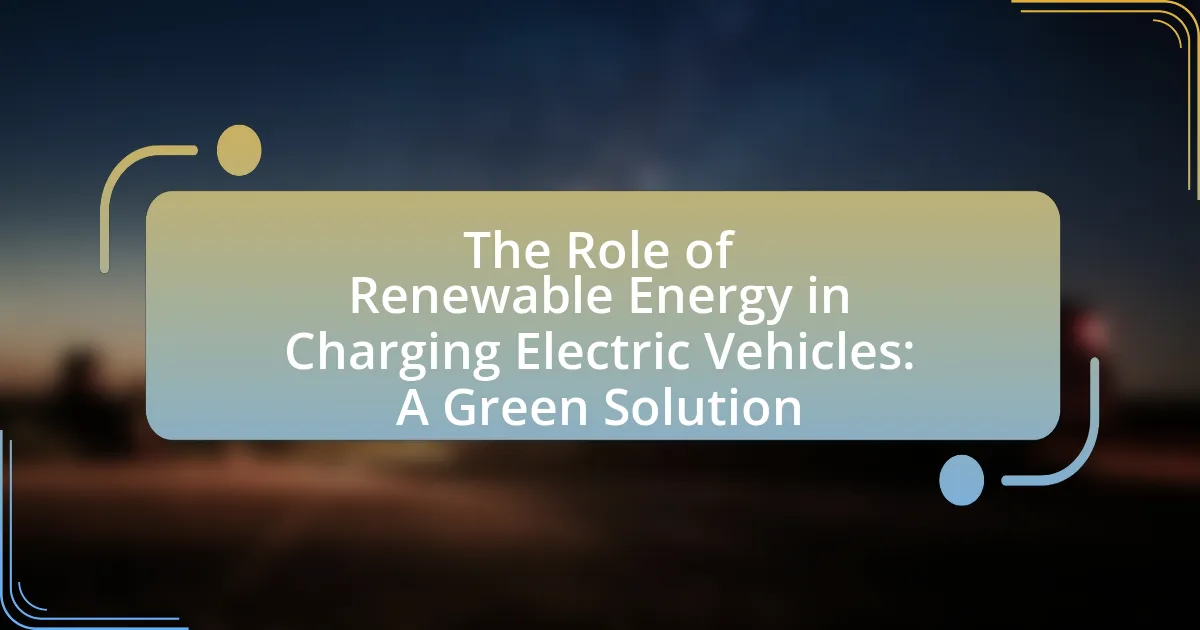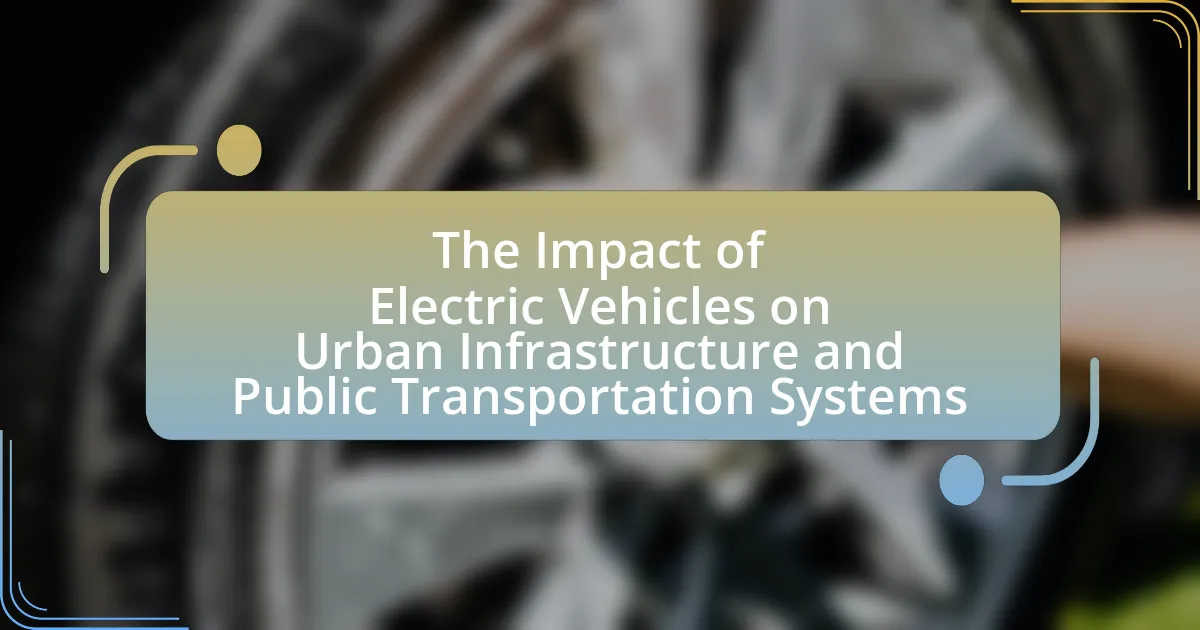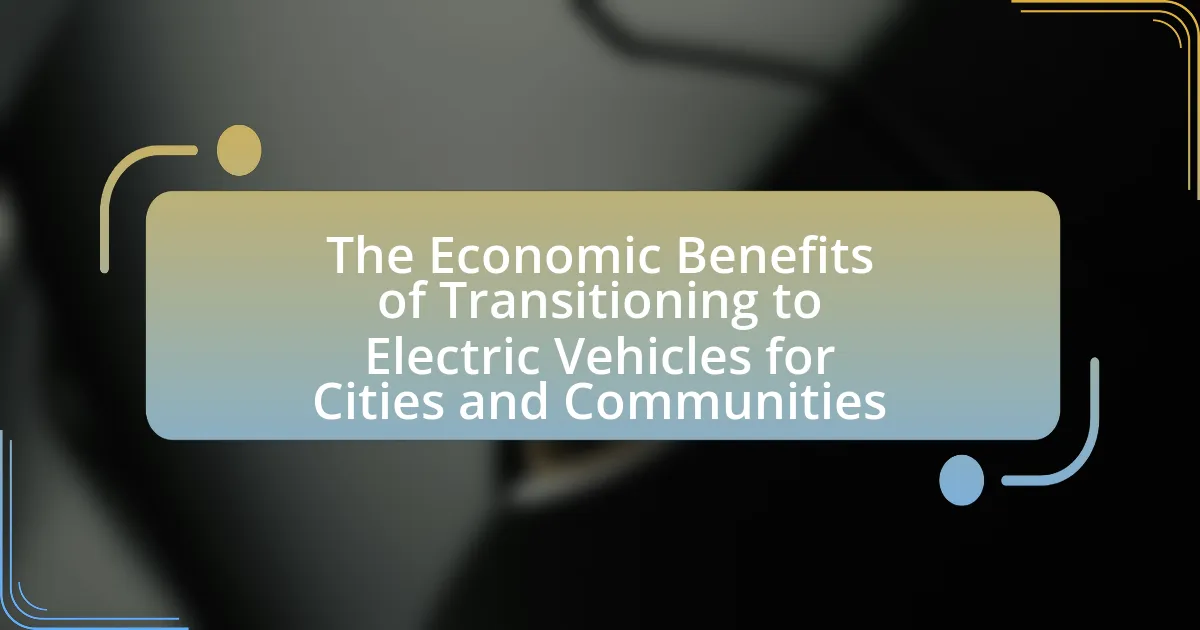The article focuses on analyzing the lifecycle emissions of electric vehicles (EVs) compared to traditional gasoline cars. It defines lifecycle emissions as the total greenhouse gas emissions produced from a vehicle’s production to its disposal, highlighting the stages involved, including manufacturing, fuel consumption, and end-of-life disposal. Key factors influencing these emissions are discussed, such as manufacturing processes, fuel types, and vehicle efficiency. The article emphasizes the importance of lifecycle emissions analysis in understanding the environmental impact of vehicles, revealing that EVs generally produce lower emissions over their lifespan, particularly when powered by renewable energy. Additionally, it explores future trends in emissions analysis and the role of government policies in promoting lower emissions vehicles.
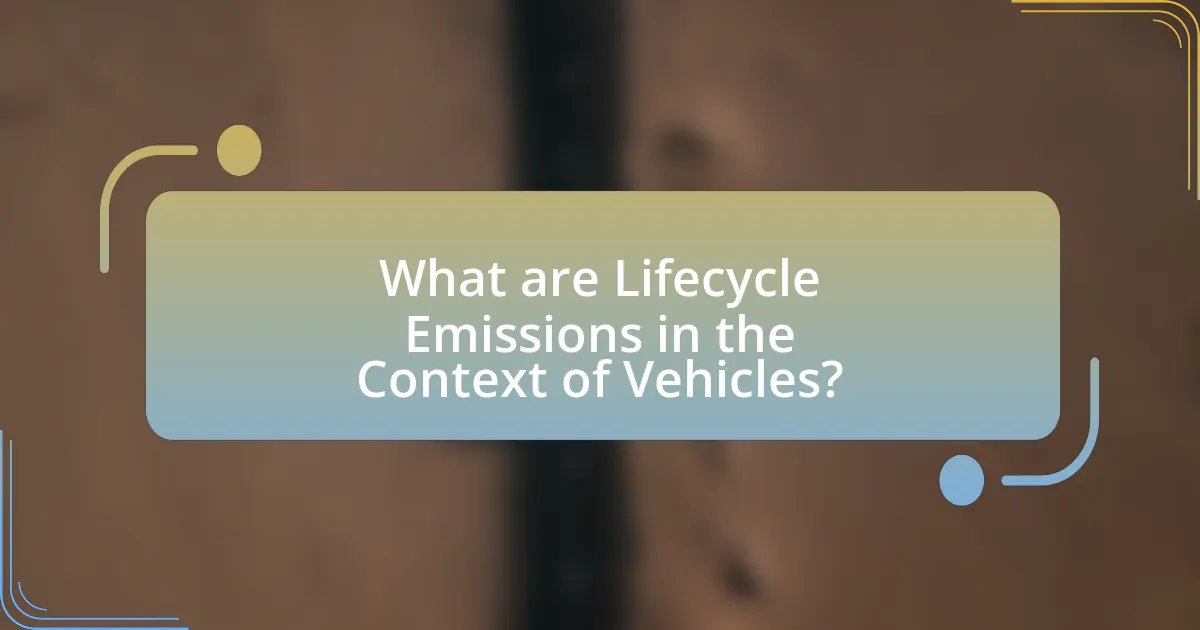
What are Lifecycle Emissions in the Context of Vehicles?
Lifecycle emissions in the context of vehicles refer to the total greenhouse gas emissions produced throughout a vehicle’s entire lifespan, from production to disposal. This includes emissions generated during the manufacturing process, fuel extraction and refining, vehicle operation, and end-of-life disposal or recycling. For instance, a study by the Union of Concerned Scientists indicates that electric vehicles can produce lower lifecycle emissions compared to traditional gasoline cars, primarily due to the emissions associated with electricity generation and vehicle manufacturing.
How are lifecycle emissions defined and measured?
Lifecycle emissions are defined as the total greenhouse gas emissions produced throughout the entire lifecycle of a product, from raw material extraction to manufacturing, use, and disposal. These emissions are measured using a method called Life Cycle Assessment (LCA), which quantifies the environmental impacts associated with all stages of a product’s life. LCA involves compiling an inventory of relevant energy and material inputs and environmental releases, assessing the potential environmental impacts associated with those inputs and releases, and interpreting the results to inform decision-making. This methodology is standardized by organizations such as ISO 14040 and ISO 14044, which provide guidelines for conducting LCAs and ensure consistency and reliability in measuring lifecycle emissions.
What stages are included in the lifecycle of a vehicle?
The lifecycle of a vehicle includes several key stages: raw material extraction, manufacturing, distribution, use, and end-of-life disposal. Each stage contributes to the overall environmental impact of the vehicle. For instance, raw material extraction involves mining for metals and minerals, which can lead to habitat destruction and pollution. Manufacturing encompasses the production of vehicle components and assembly, often resulting in significant energy consumption and emissions. Distribution refers to the transportation of vehicles to dealerships, which also contributes to carbon emissions. The use phase is where vehicles consume fuel or electricity, directly impacting emissions based on energy sources. Finally, end-of-life disposal includes recycling or landfilling, affecting resource recovery and environmental sustainability. These stages collectively determine the lifecycle emissions of both electric vehicles and traditional gasoline cars.
Why is it important to analyze lifecycle emissions?
Analyzing lifecycle emissions is important because it provides a comprehensive understanding of the total environmental impact of a product from production to disposal. This analysis helps identify the stages where emissions can be reduced, guiding policymakers and manufacturers in making informed decisions to minimize carbon footprints. For instance, a study by the Union of Concerned Scientists found that electric vehicles can produce significantly lower emissions over their entire lifecycle compared to traditional gasoline cars, highlighting the importance of considering all phases of a vehicle’s life.
What factors influence lifecycle emissions for vehicles?
Lifecycle emissions for vehicles are influenced by several key factors, including manufacturing processes, fuel type, vehicle efficiency, and end-of-life disposal. Manufacturing processes contribute significantly to emissions due to the energy-intensive production of components, particularly batteries in electric vehicles, which can have a higher initial carbon footprint. Fuel type plays a crucial role, as gasoline vehicles emit CO2 during operation, while electric vehicles’ emissions depend on the energy mix used for electricity generation. Vehicle efficiency, measured in miles per gallon or energy consumption per mile, directly affects emissions during use; more efficient vehicles produce fewer emissions. Finally, end-of-life disposal methods, such as recycling or landfilling, impact the overall lifecycle emissions, with recycling generally leading to lower emissions compared to disposal. These factors collectively determine the total lifecycle emissions associated with both electric and traditional gasoline vehicles.
How do manufacturing processes impact emissions?
Manufacturing processes significantly impact emissions by determining the amount and type of greenhouse gases released during production. For instance, the production of electric vehicles (EVs) typically involves higher emissions due to the energy-intensive processes required for battery manufacturing, which can emit up to 150 kg of CO2 per kWh of battery capacity. In contrast, traditional gasoline cars generally have lower emissions during manufacturing but contribute more to emissions during their operational phase. Studies indicate that the overall lifecycle emissions of EVs can be lower than those of gasoline cars, depending on the energy sources used in manufacturing and electricity generation. Therefore, the choice of materials, energy sources, and production techniques in manufacturing processes directly influences the total emissions associated with both electric and gasoline vehicles.
What role does fuel type play in lifecycle emissions?
Fuel type significantly influences lifecycle emissions by determining the total greenhouse gases emitted during the production, use, and disposal phases of a vehicle. For instance, traditional gasoline cars typically produce higher emissions due to the combustion of fossil fuels, which releases carbon dioxide and other pollutants. In contrast, electric vehicles, depending on the electricity source, can have lower lifecycle emissions, especially when powered by renewable energy. A study by the Union of Concerned Scientists found that electric vehicles produce, on average, less than half the emissions of comparable gasoline cars over their lifetime, highlighting the critical role that fuel type plays in overall emissions profiles.

How do Electric Vehicles Compare to Traditional Gasoline Cars?
Electric vehicles (EVs) generally produce lower lifecycle emissions compared to traditional gasoline cars. A study by the Union of Concerned Scientists indicates that EVs can produce less than half the emissions of comparable gasoline vehicles over their entire lifecycle, including manufacturing, operation, and disposal. This reduction is primarily due to the absence of tailpipe emissions and the increasing share of renewable energy in electricity generation, which further decreases the carbon footprint associated with charging EVs. In contrast, gasoline cars consistently emit greenhouse gases throughout their operational life, contributing significantly to climate change.
What are the key differences in lifecycle emissions between electric vehicles and gasoline cars?
Electric vehicles (EVs) generally have lower lifecycle emissions compared to gasoline cars. The lifecycle emissions of EVs are primarily influenced by the manufacturing process, electricity generation, and vehicle operation, while gasoline cars emit greenhouse gases mainly during fuel combustion.
Research indicates that the production of EVs, particularly the battery manufacturing, can result in higher initial emissions; however, over their operational lifetime, EVs typically produce significantly fewer emissions due to the cleaner energy sources used for electricity generation. For instance, a study by the Union of Concerned Scientists found that, even when accounting for battery production, EVs produce less than half the emissions of comparable gasoline vehicles over their lifetime in regions with cleaner electricity grids.
In contrast, gasoline cars consistently emit CO2 and other pollutants throughout their operational life, contributing to higher overall lifecycle emissions. Therefore, while the initial emissions from EV production may be higher, their operational efficiency and the potential for renewable energy use lead to a substantial reduction in total lifecycle emissions compared to gasoline cars.
How do emissions during manufacturing differ for both vehicle types?
Emissions during manufacturing differ significantly between electric vehicles (EVs) and traditional gasoline cars, with EVs generally producing higher emissions during the production phase. The manufacturing of electric vehicles involves the extraction and processing of raw materials for batteries, such as lithium, cobalt, and nickel, which contributes to increased greenhouse gas emissions. For instance, a study by the International Council on Clean Transportation found that the production of an electric vehicle can emit approximately 60% more CO2 compared to a conventional gasoline vehicle due to battery production. In contrast, traditional gasoline cars have lower manufacturing emissions primarily because they do not require large battery systems, although they still produce emissions from the production of their engines and components. Thus, while electric vehicles have higher initial manufacturing emissions, they tend to have lower emissions over their operational lifetime compared to gasoline vehicles.
What are the emissions associated with fuel production and consumption?
The emissions associated with fuel production and consumption primarily include carbon dioxide (CO2), methane (CH4), and nitrous oxide (N2O). These greenhouse gases are released during the extraction, refining, and combustion of fossil fuels. For instance, the U.S. Environmental Protection Agency (EPA) reports that the combustion of gasoline emits approximately 8.89 kg of CO2 per gallon burned, contributing significantly to overall greenhouse gas emissions. Additionally, the production process, including drilling and refining, can release methane, a potent greenhouse gas with a global warming potential over 25 times greater than CO2 over a 100-year period. Therefore, both the production and consumption phases of fossil fuels are critical contributors to climate change through their associated emissions.
What are the environmental impacts of electric vehicles versus gasoline cars?
Electric vehicles (EVs) generally have lower environmental impacts compared to gasoline cars, particularly in terms of greenhouse gas emissions and air pollutants. EVs produce zero tailpipe emissions, which significantly reduces local air pollution, while gasoline cars emit carbon dioxide, nitrogen oxides, and particulate matter during operation.
Lifecycle assessments indicate that, even when accounting for emissions from electricity generation, EVs typically result in lower overall emissions. For instance, a study by the Union of Concerned Scientists found that EVs produce, on average, less than half the emissions of comparable gasoline vehicles over their lifetime, including manufacturing, operation, and disposal phases. Additionally, as the energy grid becomes greener with more renewable sources, the emissions associated with EVs continue to decrease, enhancing their environmental benefits over time.
How do electric vehicles contribute to reduced greenhouse gas emissions?
Electric vehicles (EVs) contribute to reduced greenhouse gas emissions primarily by eliminating tailpipe emissions, which are a significant source of carbon dioxide and other pollutants from traditional gasoline cars. Unlike gasoline vehicles that burn fossil fuels, EVs operate on electricity, which can be generated from renewable sources such as wind, solar, and hydroelectric power. According to the U.S. Department of Energy, EVs produce, on average, less than half the emissions of conventional vehicles over their lifetime when considering the entire energy production process. This reduction is further enhanced as the electricity grid becomes greener, with a growing share of renewable energy sources.
What are the potential drawbacks of electric vehicle emissions?
Electric vehicle emissions can still have significant drawbacks, primarily due to the production and disposal of batteries. The manufacturing process of lithium-ion batteries, which power most electric vehicles, generates substantial greenhouse gas emissions, estimated at around 150 to 200 kg of CO2 per kWh of battery capacity. Additionally, the mining of lithium, cobalt, and nickel for these batteries can lead to environmental degradation and pollution. Furthermore, when electric vehicle batteries reach the end of their life, improper disposal can result in toxic chemical leakage, posing risks to soil and water quality. These factors highlight that while electric vehicles reduce tailpipe emissions, their overall lifecycle emissions can still be concerning.

What are the Future Trends in Vehicle Emissions Analysis?
Future trends in vehicle emissions analysis focus on enhanced data analytics, real-time monitoring, and lifecycle assessments. Advanced data analytics will leverage machine learning algorithms to predict emissions based on driving patterns and vehicle performance, improving accuracy in emissions reporting. Real-time monitoring technologies, such as onboard diagnostics and telematics, will enable continuous emissions tracking, allowing for immediate adjustments and compliance with regulations. Lifecycle assessments will increasingly consider the entire production and disposal process of vehicles, particularly electric vehicles, to provide a comprehensive view of their environmental impact. According to a study by the International Council on Clean Transportation, lifecycle emissions analysis is becoming essential for understanding the true environmental benefits of electric vehicles compared to traditional gasoline cars.
How is technology evolving to reduce lifecycle emissions?
Technology is evolving to reduce lifecycle emissions through advancements in electric vehicle (EV) battery efficiency, renewable energy integration, and sustainable manufacturing processes. For instance, improvements in lithium-ion battery technology have led to higher energy densities and longer lifespans, which decrease the overall emissions associated with battery production and disposal. Additionally, the integration of renewable energy sources, such as solar and wind, into the charging infrastructure significantly lowers the carbon footprint of EVs during their operational phase. Furthermore, manufacturers are increasingly adopting circular economy principles, focusing on recycling materials and reducing waste in the production of vehicles, which contributes to lower lifecycle emissions. According to a study by the International Council on Clean Transportation, electric vehicles can produce up to 70% lower lifecycle emissions compared to traditional gasoline cars when charged with renewable energy.
What innovations are being developed in electric vehicle technology?
Innovations in electric vehicle technology include advancements in battery chemistry, such as solid-state batteries, which promise higher energy density and faster charging times. These batteries utilize solid electrolytes instead of liquid ones, enhancing safety and longevity. Additionally, improvements in electric motor efficiency and regenerative braking systems are being developed to maximize energy recovery and extend driving range. Research from the U.S. Department of Energy indicates that solid-state batteries could potentially increase the range of electric vehicles by 30% compared to current lithium-ion batteries. Furthermore, the integration of artificial intelligence for optimizing energy management and autonomous driving capabilities is also a significant focus, aiming to improve overall vehicle performance and user experience.
How can traditional gasoline cars be made more efficient?
Traditional gasoline cars can be made more efficient by implementing advanced engine technologies, such as turbocharging and direct fuel injection, which enhance fuel combustion and reduce waste. These technologies can improve fuel economy by up to 20% compared to conventional engines. Additionally, regular maintenance, including timely oil changes and air filter replacements, ensures optimal engine performance, contributing to better fuel efficiency. According to the U.S. Department of Energy, maintaining proper tire pressure can also improve fuel economy by 3% to 4%. Furthermore, reducing vehicle weight through the use of lighter materials can enhance efficiency, as lighter vehicles require less energy to operate.
What policies are influencing the shift towards lower emissions vehicles?
Government policies are significantly influencing the shift towards lower emissions vehicles through regulations, incentives, and funding initiatives. For instance, many countries have implemented stringent emissions standards that require automakers to reduce greenhouse gas emissions from their vehicles, such as the European Union’s Euro 6 standards and California’s Advanced Clean Cars Program. Additionally, financial incentives like tax credits for electric vehicle purchases and subsidies for manufacturers to develop cleaner technologies encourage consumers and companies to transition to lower emissions options. Furthermore, investments in charging infrastructure and renewable energy sources support the broader adoption of electric vehicles, as seen in the U.S. government’s commitment to build a nationwide network of charging stations. These policies collectively drive innovation and consumer behavior towards more sustainable transportation solutions.
How do government incentives affect electric vehicle adoption?
Government incentives significantly increase electric vehicle adoption by reducing the overall cost for consumers. Financial incentives such as tax credits, rebates, and grants lower the purchase price of electric vehicles, making them more accessible. For instance, in the United States, the federal tax credit can provide up to $7,500 off the purchase price, which has been shown to boost sales. According to a study by the International Council on Clean Transportation, countries with robust incentive programs, like Norway, have seen electric vehicle market shares exceed 54% of new car sales in 2020, demonstrating a direct correlation between incentives and adoption rates.
What regulations are being implemented to reduce emissions from gasoline cars?
Regulations being implemented to reduce emissions from gasoline cars include stricter fuel economy standards and emissions limits set by government agencies. For instance, the U.S. Environmental Protection Agency (EPA) has established the Corporate Average Fuel Economy (CAFE) standards, which require automakers to achieve an average fuel economy of 54.5 miles per gallon by 2025. Additionally, California’s Advanced Clean Cars program mandates lower greenhouse gas emissions and promotes the adoption of zero-emission vehicles. These regulations aim to decrease the overall carbon footprint of gasoline vehicles, contributing to climate change mitigation efforts.
What practical steps can consumers take to minimize vehicle emissions?
Consumers can minimize vehicle emissions by adopting several practical steps. First, they can choose fuel-efficient or electric vehicles, which produce significantly lower emissions compared to traditional gasoline cars; for instance, electric vehicles can reduce greenhouse gas emissions by up to 50% over their lifetime compared to gasoline vehicles. Additionally, regular vehicle maintenance, such as timely oil changes and air filter replacements, ensures optimal engine performance and reduces emissions.
Furthermore, consumers can adopt eco-driving practices, such as smooth acceleration and braking, which can improve fuel efficiency by 10-30%. Carpooling or using public transportation also decreases the number of vehicles on the road, thereby reducing overall emissions. Lastly, consumers can limit idling time, as idling can waste fuel and contribute to unnecessary emissions; studies show that turning off the engine when parked can save up to 0.6 gallons of fuel per hour.
How can consumers make informed choices when purchasing vehicles?
Consumers can make informed choices when purchasing vehicles by researching and comparing the lifecycle emissions of electric vehicles and traditional gasoline cars. This involves understanding the total environmental impact, including manufacturing, usage, and disposal phases. Studies, such as the one published by the Union of Concerned Scientists, indicate that electric vehicles typically produce lower emissions over their lifetime compared to gasoline cars, even when accounting for electricity generation. Additionally, consumers should consider factors like fuel efficiency, maintenance costs, and available incentives for electric vehicles, which can further influence their decision-making process.
What maintenance practices can help reduce emissions in both vehicle types?
Regular maintenance practices such as timely oil changes, proper tire inflation, and routine engine checks can significantly reduce emissions in both electric vehicles and traditional gasoline cars. For gasoline vehicles, maintaining the engine and exhaust system ensures optimal combustion efficiency, which lowers harmful emissions. In electric vehicles, ensuring that the battery is in good condition and that software updates are applied can enhance energy efficiency, thereby reducing overall emissions associated with electricity generation. Studies indicate that well-maintained vehicles can emit up to 30% fewer pollutants compared to poorly maintained ones, highlighting the importance of these practices in minimizing environmental impact.
